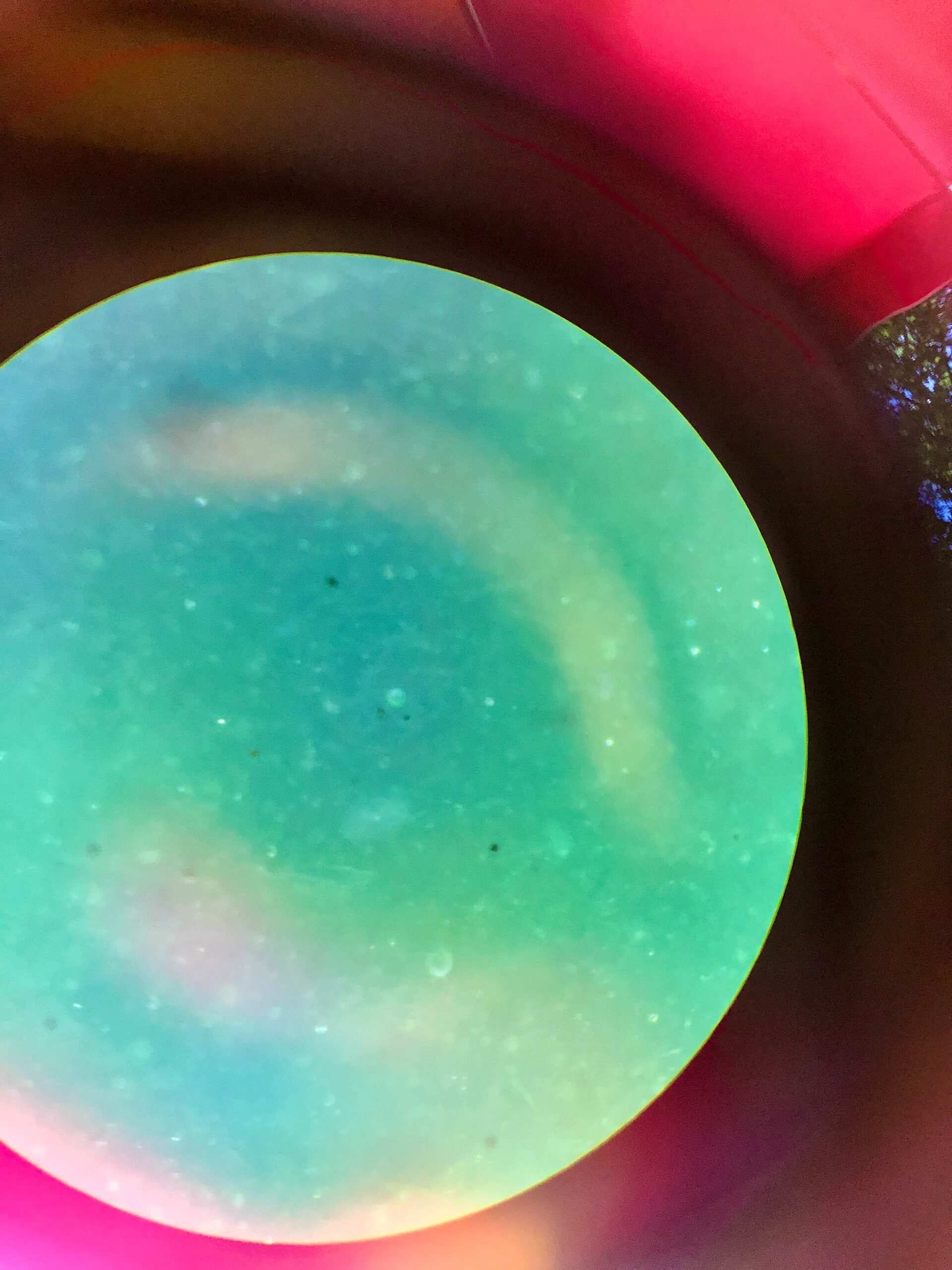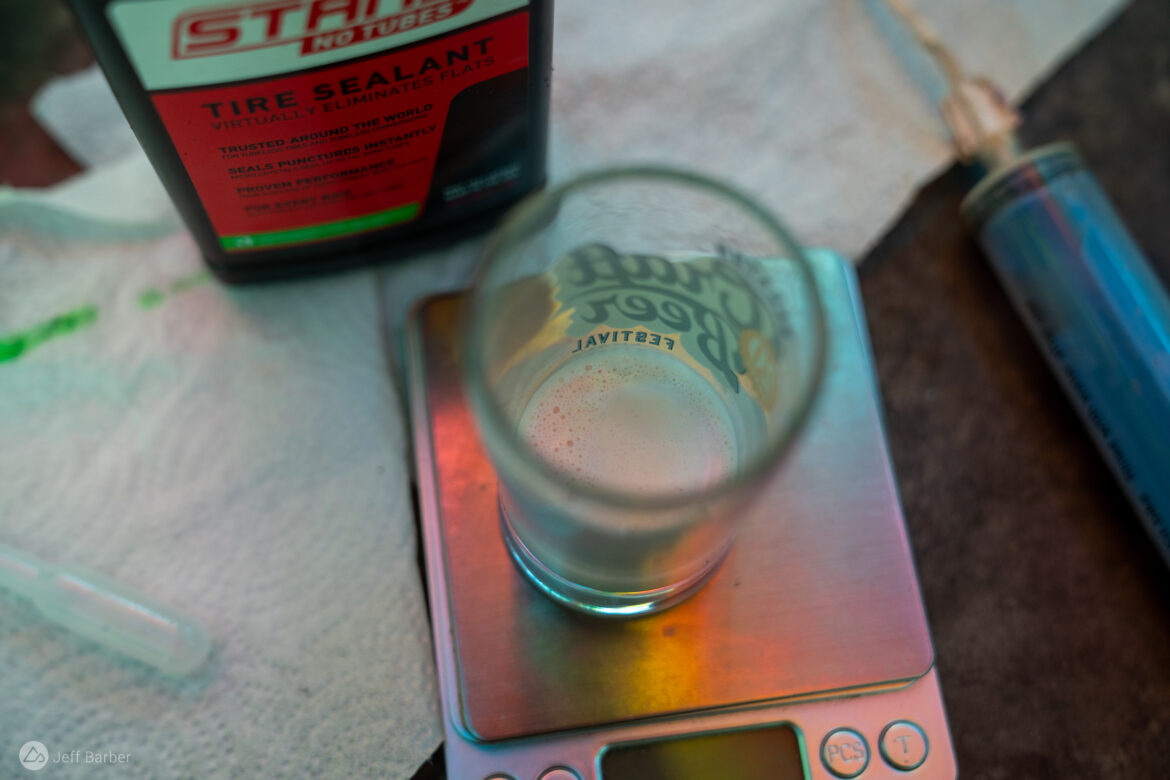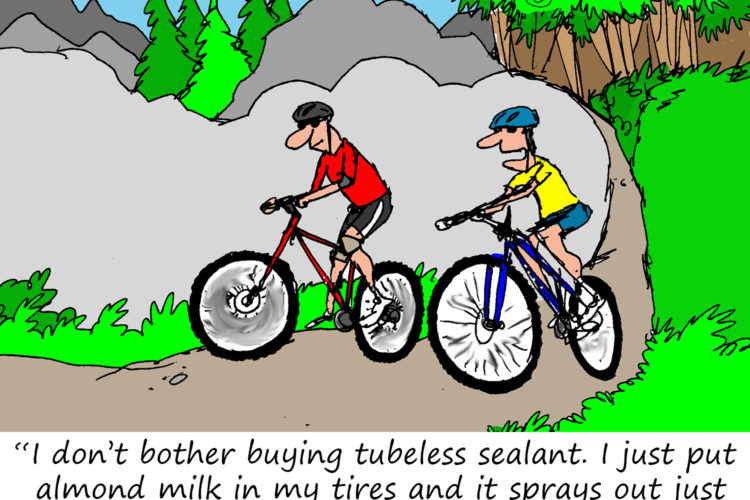
Flat tires blow. I mean that literally; whether a tire loses air slowly over time or quickly and all at once. Tubeless tire sealant is designed to stop that flow when it comes to punctures and tears, which is super helpful on the trail. At least, when it works.
Four years ago Singletracks contributor Patrick Goral conducted a long-term test to see how long various tubeless tire sealants lasted inside a tire before drying out or becoming ineffective, so I decided to follow up and see just how well they seal when they’re fresh. Despite witnessing plenty of tire sealant fails on the trail from various brands over the years, all of the sealants in this test crop performed similarly well, for the most part.
Check out a summary of the findings below, then read on to learn how I set up my test and how each sealant performed.
Summary tldr;

Test results
| Amount (oz) | Starting (psi) | Ride (psi) | 10-minute (psi) | Remaining (oz) | |
| Slime All Tire sealant | 4 | 19.9 | 12.9 | 12.1 | – |
| Orange Seal (Regular) | 4 | 20.1 | 19.3 | 18.6 | 3 |
| Finish Line FiberLink | 4 | 20.1 | 19.7 | 19.6 | 3 |
| Muc-off | 4 | 20.1 | 19.5 | 19.6 | 0.5 |
| Stans | 4 | 20.1 | 19.7 | 20.3 | 3.5 |
| Slime, second test | 4 | 20.0 | 19.2 | 18.7 | – |
You can read the details of my test setup below, but the jist is that I poked a hole in a tire to find out how quickly each sealant acted by noting how much air pressure the tire lost before the puncture was sealed. The chart above shows that in all but one of the tests, less than one PSI of pressure was lost, which is pretty impressive. My experimental setup was way too loose to have better than a one PSI margin of error so I’m calling all of these good, and would recommend all of them — though some with caveats — for effectively sealing medium-size tire punctures.
From this test I learned a lot about how tire sealants work relative to one another, and perhaps the most telling test was actually the drip test shown above.
- Slime is the most viscous of the bunch, and forms a nice coating on inside of the tire. However that also makes it slower to seal punctures.
- Orange Seal is the least dense sealant tested, adding the least amount of weight to the tire setup.
- Slime is the least expensive per ounce, but you need to use more of it. Orange Seal is the most expensive per ounce.
- Stans works fast and has the best overall recovery amount.
- Muc-off strikes more of a balance between being runny and sticky than others.
- Finish Line is fairly similar in terms of properties and performance to Stans and Orange Seal.
- All of the sealants claim to be able to seal punctures up to about 6mm. Stans and Orange Seal claim they can do a bit better, at 6.35mm and 6.5mm, respectively.
- Setting a tire in the sun can raise the internal pressure fairly significantly. This could come in handy when every psi counts.
Tubeless tire sealant test setup
I’ll start by stating that while this test was inspired by science, I’m not a scientist by any means, and plenty of errors were likely introduced into my results. Put another way, I had fun using pipets, scales, gauges, and even a microscope but if the FDA were watching me, I would be banned from ever making baby formula again. Also, everyone’s Covid test would come out positive.

We’ve attempted other experiments in the past and one of the most common criticisms tends to be that the test isn’t real-world enough. IMO that’s exactly the point, you know eliminating variables and all, but I also understand where readers are coming from. Mountain biking is dirty, and messy, and just because something is proven under artificial conditions doesn’t mean the same will hold true out on the trail.
So rather than poke holes in tires and observe them on a work bench, I decided to do what most of us do on the trail whenever we get a puncture: spin the tire so the hole is at the bottom, wait for the sealant to stop spraying out, squeeze the tire for a quick pressure check, and then get back at it!
For the experiment I filled a well-used Vittoria Syerra tire, mounted on my hardtail in the rear, with 4oz. of sealant. I inflated the tire to 20PSI (or as close as I could get it, noted in the starting pressure column above) and checked for any initial leaks. Then I poked a 3mm hole in the tire using a pick tool. Upon removing the pick I spun the hole to the bottom and jiggled the tire a couple times until the puncture began to seal. Next, I hopped on the bike for a roughly one minute test track loop that included a three-foot jump, short rock garden segment, multiple sharp corners, a large log roll, and finally a climb back to the top.

Immediately after finishing the course I measured the pressure in the tire (the ride pressure column in the table above) using a digital gauge. Then I let the tire sit for 10 minutes, again with the hole at the bottom, to determine if the tire was still slowly leaking (the 10-minute pressure column).
Following the test I measured how much sealant was left inside the tire (the remaining column) and cleaned the inside of the tire and bead thoroughly. I also plugged the hole with a proper tire plug, and used water to verify that no air was escaping from the plugged location. And repeat.

In addition to the on-trail test I also tried to calculate the specific gravity of each sealant and did a drip test to visually get a sense of their viscosities. I even looked at a few under a microscope to see if I could find any clues about how they work.
Tubeless tire sealants
I chose this batch of sealants based mainly on popularity and availability. Like in Pat’s test it was important to include Stans and Orange Seal since they are so well known, and also to add to his findings about their longevity. Here I’ll talk about each sealant based on the order it was tested since I suspect that may have influenced the results a bit.
| Specific gravity* | Max hole | $/oz.** | |||
| Slime All Tire sealant | 1.24 | 6mm | $0.53 | ||
| Orange Seal (regular) | 1.00 | 6.35mm | $1.28 | ||
| Finish Line FiberLink | 1.04 | – | $1.25 | ||
| Muc-off | 1.06 | 6mm | $0.89 | ||
| Stans (original) | 1.04 | 6.5mm | $1.06 |
Slime “All Tire” Sealant



Walk into the bike aisle at your local Walmart and you’re likely to find Slime products, which can’t be said for any of the other brands we tested. In preparing for this test I learned that Slime is offered in different formulations and packaging, including one that’s made specifically for bicycle tires. However, that’s not the one I used. Instead I opted for the “All Tire” version which is said to work for not just bicycle tires but also tractor, golf cart, and ATV tires. It seems this is the version you’re most likely to find in a pinch, so I wanted to know how well it works.
The 32oz bottle I tested says to add 8oz of sealant for a motorcycle tire, but doesn’t list an amount for bike tires. Looking online I found a chart that says to add 4oz for bike tires, but it also says a 16oz bottle fills two bike tires, which clearly doesn’t add up. Since 4oz is in line with the recommended range for all the other sealants in the test, that’s how much I used, and I think it turned out to be not enough based on the first run. To be fair I tested Slime again at the end of the test, and it performed much better which suggests the order of testing did affect the numbers.

Slime is the most dense, and the most viscous, sealant I tested. Not only that, it’s the only sealant that effectively had a zero recovery rate. That is, I couldn’t really slurp any of it up with a syringe after the test. Even measuring the liquid the first time was a chore; it just doesn’t want to flow. In the test the sealant proved to be slow to find the puncture, and once it did, there wasn’t a big pool of liquid since most of the 4oz was already coating the inside of the tire. It seems like this coating should be really effective, and it likely is, but the tradeoff is that it’s slow to seal. To compensate I would recommend adding 6oz or even 8oz for a typical 29er tire.
Priced at about $0.53 per ounce, Slime is by far the cheapest sealant I tested, but keeping in mind the need to up the dosage it’s less of a deal.
Stock up on Slime tire sealant at Amazon.
Orange Seal regular

Orange Seal is a familiar sealant choice to most mountain bikers, second perhaps only to Stans. As you can see from the drip test, Orange Seal is the least viscous of the five sealants I tested, running completely off the plate. As measured, the specific gravity of Orange Seal is basically 1.0, the same as water. Like I said at the beginning, my measurements weren’t all that precise and the true specific gravity is probably a bit higher. The point is, it’s the lowest of the bunch and that doesn’t seem to negatively affect performance, so weight weenies take note.
Looking at the pressure experiment data, Orange Seal appears to have lost a bit more pressure than the others tested, though I can’t say definitively that’s true. Again, the order of testing could have have played a role, with sealants tested later performing best.
I wasn’t sure what to expect when comparing the price of sealants. As it turns out Orange Seal is the most expensive of the bunch on a cost-per-ounce basis when buying the 32oz size, though it’s just a few cents more than the next most expensive.
Stock up on Orange Seal at Amazon.
Finish Line FiberLink


Finish Line sealant has undergone a bit of a rebranding since Pat’s long-term sealant test, where he found the product lived up to its claim of never drying, though the liquid suspension also separated over time and wasn’t that effective at keeping a seal. In my short-term test it performed just as well as any of the others, and its properties line up pretty closely with Stans and Orange Seal, just with a bit more density and viscosity.
FiberLink is said to include Kevlar fibers to help reinforce seals, though under the microscope I couldn’t really detect them. Finish Line provides a more detailed range for sealant amounts based on tire size than some of the others, suggesting 4-5oz of sealant for 29er tires, and 5-6oz for 29+ tires. With “standard” tire widths creeping up a bit these days, my best guess is that I should be using 5oz for my 2.5-inch tires. That’s an extra ounce compared to the Stans recommendation (4oz for tires up to four inches wide) and Orange Seal, and roughly on par with Muc-off. Priced at $1.25 per ounce, it’s the second most expensive sealant I tested, so that extra ounce per tire starts to add up.
Stock up on Finish Line Fiberlink at Trek and other online retailers.
Muc-off


In the spirit of full transparency, Muc-off has been my go-to sealant for a while now. I haven’t had any unreasonable flats with it, and I think I just like the look and the smell, like a pop of neon with that new wall-to-wall carpet smell. That being said, based on my test there doesn’t seem to be any real performance benefit to it, and because it works a bit differently than the more mainstream sealants, it might not be for everyone.
Like Slime, Muc-off does a good job coating the inside of a tire. Following my test I was only able to recover about half an ounce of sealant, with the other three and a half ounces spread along the inner surface. However unlike Slime, I found Muc-off sealed rather quickly, sloshing its way to the puncture rather than just oozing. It’s clear from the drip test that Muc-off does have some movement to it, but it’s still quite viscous. It’s also the second most dense of the sealants I tested.
Under the microscope I saw what appear to be fibers of some sort. Muc-off says the sealant contains “cutting-edge molecules,” though I don’t think that’s them since my microscope was only set to 100x magnification. There’s also UV dye in the Muc-off sealant which is supposed to help identify leaks, and I’ve tried that, but haven’t found it to be very helpful compared to a good old fashioned soapy water test. In spite of all this tech, Muc-off is notably less expensive per ounce than all but Slime. I’ll continue using Muc-off at home, though I think I’ll add an extra ounce or so just to make sure it keeps flowing inside the tire.
Stock up on Muc-off sealant at Performance Bike and other online retailers.
Stans original

The Stans tire lost the least amount of pressure in the ride test, and was the only one to actually gain pressure in the ten-minute test. The first is easy to explain; Stans was the last one to be tested so I got pretty good at checking the pressure with my digital gauge without accidentally letting too much pressure out of the valve. As for the pressure gain, the tire was sitting in direct sunlight during the ten-minute test, making the tire noticeably hot to the touch, and no doubt increasing the pressure in the tire. My takeaway: if you don’t have a pump on you but need to top off your pressure, just let your tire sit in the sun for a bit. I got more than half a PSI in just ten minutes!
Stans is notable for being the second runniest in the test (i.e. the least viscous) and it seems to be in good company with Orange Seal, the only sealant to completely run off the plate. As we all know, the stuff basically looks like milk, and as a point of reference I measured some actual 2% milk to compare. According to my calculations Stans has a specific gravity of about 1.04, compared to 1.02 for some 2% milk I had in the fridge (this page says 2% milk should have a specific gravity of 1.03 so I’m not too far off). At the end of the test I was able to Hoover up nearly 3.5oz with a syringe which suggests very little sealant was lost through the puncture, and that it tended to roll around inside the tire rather than sticking to it. This recovery rate was best in test.
Finally, I’ll note that Stans was one of just two sealants that completely sealed the hole without the need for a tire plug in between tests, as verified with a bubble test.
Stock up on Stans at JensonUSA and other online retailers.
Show your Support
Become a Singletracks Pro Supporter today and enjoy benefits like ad-free browsing.
With your support we can provide free worldwide trail information and original content created by our team of independent journalists.



















